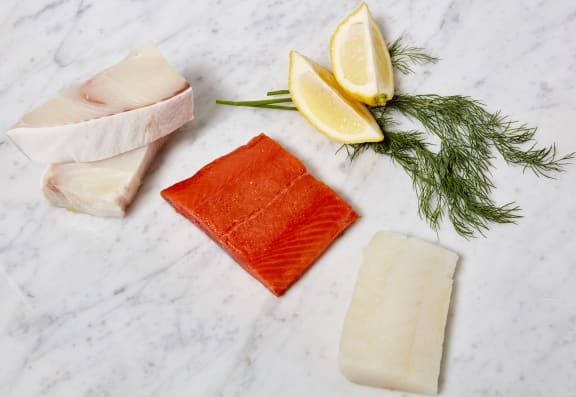
Which Fish Should I Use?
February 25th, 2021How to Dial In On the Right Species for a Dish
Coho or sockeye? Cod, halibut, or another type of mild white fish? Whether you’re freestylin’ in the kitchen with wild-caught seafood or are following a particular recipe, it’s not always clear which variety of fish is going to be the best choice of protein for your dish. Sure, all varieties have salmon share something in common, and many white-fleshed fillets taste alike and even look alike.
But with a little guidance on what sets one fillet apart from the other, you can really dial in your recipes to choose your protein with the confidence of a pro.
A Tale of Two Salmons
Some recipes out there specify which species of salmon to use, but more often than not, they’re actually written out for the average consumer who is buying what’s available from their local fishmonger — usually, farmed Atlantic salmon. So which variety of wild salmon should you use instead?
It helps to understand the difference between sockeye and coho, which you can explore in depth in our blog post on the subject. In short, from a culinary standpoint, sockeye is notable for its salmon-forward flavor. This makes it a good match for when you want to highlight this gamey flavor in bold preparations, since it’s meaty flavor profile can hold up to grilling, intensely flavored marinades and rubs, and anything spicy. If you’re someone who’s weaning yourself off of red meat and wondering what to eat when you find yourself in a “meat and potatoes” mood, there’s nothing better than a pan-seared fillet of sockeye.
Sockeye is also known for its intense color — it’s earned the nickname “red salmon” for that reason — so if you’re looking to impress someone with a gorgeous meal that is a feast for the eyes (even if that someone is yourself) sockeye is a stunning beauty. It’s also the leaner of the two varieties of salmon, which makes it the salmon of choice when you want to cure up a batch of gravlax.
Coho is a milder variety of salmon, with a subtle salmon flavor that makes it easier to use when your recipe is also on the milder side. It still tastes like salmon, but its chill flavor profile won’t dictate the overall flavor profile of your recipe. A fillet of coho plays nicely with tender herbs, with recipes that call for poached or steamed salmon, and is also going to be your go-to salmon when you’re cooking for picky eaters who might be put off by sockeye’s bold flavor.
While coho is definitely a lean variety of wild-caught salmon, it has a higher fat content than sockeye. This gives you a little more grace when you’re new to cooking wild salmon and not sure when to pull it from the heat so that it doesn’t dry out — so coho is a great “starter salmon” to work with.
Sorting Out Your White Fish
Many recipes that call for a white-fleshed fish won’t specify which type is best to use. Some list three or four different varieties, leaving the choice up to you, while others may just call for a fillet of “white fish” that has a particular texture or flavor. In the case of recipes that work with firm, mild fillets of white fish, wild Alaskan varieties of cod, halibut, pollock and rockfish are largely interchangeable — in a pinch, you can often use one in place of another. There are, however, some unique qualities to each of these species that set them apart from each other.
Halibut is mild in flavor but is perhaps the meatiest of all of these varieties, having the largest, firmest flakes. It’s a nice fillet to use when you’re in the mood for something hearty, whether in a stew, as a grilled fillet to use for sliders or full-on fish sandwiches, or poached in a broth to serve with noodles. One thing to keep in mind is that halibut gets quite tough when it’s overcooked, almost like an overcooked pork chop, so you might want to avoid broiling it unless you know you can keep a close eye on its doneness.
An easy substitute for halibut in practically any recipe is cod, a fish that differs mostly in its texture. Like halibut, it’s mild with large flakes, but more tender than meaty; this means it’s a bit more delicate, so it can be a bit trickier to grill. But with its clean in flavor, it melds together with any seasoning or sauce you put on it, making it a great choice for stewy dishes (cod is a quintessential choice of protein for chowder), bubbling casseroles, stir-fries of any kind, and recipes where you want to poach or steam a tasty fillet to perfection. And of course, if you’re frying anything up in a batter for tacos or fish and chips, cod ought to be your number one choice of fish.
Also mild, lean, and firm but not as distinct in flavor, our pollock Quick Cuts can be used in place of cod in recipes where, obviously, the integrity of having a whole fillet is not important. You’d never want to use quick cuts to replicate a pan-seared fillet of cod, for example, nor would you cook pollock Quick Cuts en papillote or by steaming or poaching. However, it’s a more than suitable stand-in for cod in chowders, casseroles, stir-fries, or fried as protein for your tacos or just as little delicious bites.
Rockfish is the final white fish on this list, and it’s perhaps the leanest in texture. Firm and easily adaptable in flavor, the main characteristic that sets this variety of fish apart from halibut, cod, or pollock is its size. Generally, the portions of rockfish that you get will be full fillets rather than cuts from larger fillets. They’ll also be thinner than the rest, so you might not want to use rockfish when your recipe calls for hearty chunks of fish due to the effect this will have on cook time or even the aesthetics of something like a cioppino. Because rockfish is thin though, offering you much more surface area than an equal portion of another variety of white fish, it is an excellent protein to use in dishes where you’re breading or battering fish to bake or fry — since more of your surface can get crispy.
Ultimately, there really are no rules to which white fish to use and when. You might even decide to use white fish in place of salmon or salmon in place of white fish. Experiment with all of the wild-caught varieties of fish in different preparations to see what your preferences are, and write up your own rules for which fish goes with what dish.





